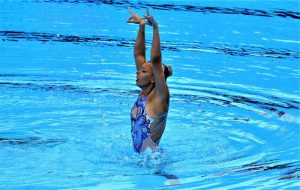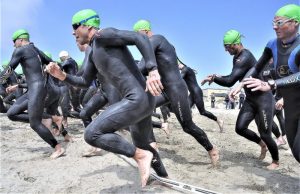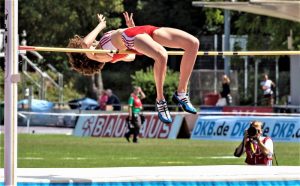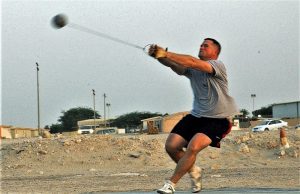Synchronized swimming
Synchronized swimming is a combination of dance and gymnastics accompanied by music that takes place in the water. This beautiful sport, also known as water ballet, is an exhibition through swimming in which the movements of one or more swimmers are synchronized with a musical accompaniment. Due to a similarity with dance, it is sometimes called aquatic ballet, especially in theatrical situations. The sport was developed in the United States in the 1930s. Synchronized swimming is an amateur sport organized in many areas of the world under the general supervision of the International Amateur Swimming Federation, which publishes a list of acrobatics, movements and figures that are accepted into competition.

Related topics
Swimming
What is synchronized swimming?
It is a sport that involves the combination of other sports such as swimming, dancing and gymnastics. The movements are performed in synchronized choreographies that are performed to the sound of music.
About synchronized swimming
Synchronized swimming consists of a group of great aquatic skills, of great physical endurance and flexibility, grace, art and precision in time, as well as exceptional endurance to hold one’s breath underwater. Competition consists of two basic parts: technical exercise and free exercise. The judges value the technical and artistic quality of both routines and are able to award a maximum of 10 points in total. Swimmers can be penalized if they touch the bottom of the pool or if they ever hold on to the edges.
History of synchronized swimming
The first samples of this sport date from the late nineteenth century, mainly during the year 1982 in England. At that time, the sport was known as artistic swimming or water ballet. Sometime later, during the 20th century, the term synchronized swimming was born. In 1920 it was also called ornamental swimming. The sport began to gain followers and was developing every day more.
In 1924, the first competition of this interesting discipline was held in Canada, specifically in Montreal, and in 1926, the first championship of figures and styles in water took place. During the years 1933 and 1934, was one of the most striking shows of the time known as “Modern Sirens” where emerged for the first time the term Synchronized Swimming.
A few years later it was possible to draw up a regulation governing sport. In 1955, this sport was included in the Pan American Games held in Mexico and the first international competition took place in Amsterdam. In 1973, it was included in the different world championships and in 1948 it was included in the Los Angeles Olympic Games.
Rules
- With regard to the technical part, the participants carry out individual competitions for 2 minutes, during which time they perform 7 different routines or elements that are mandatory. When the competition is performed in pairs, participants have the same amount of time, but must perform 9 different routines with a margin of 10 seconds.
- Mirror actions are prohibited.
- When team competitions are held, they have 3 minutes to perform a total of 19 different elements, a circular formation and a straight line.
- Free artistic elements can be incorporated, and compulsory movements are not carried out when the performance is free.
- It starts outside the pool and you have 10 seconds to enter it.
- When the performance is freestyle the participants have 6 and 8 minutes.
- Swimmers may not be out of the water for more than 10 seconds and must not touch the bottom of the pool.
- The costumes must not have transparent fabric.
- All participants must perform a freestyle routine and a combined routine.
Categories
There are two different categories of synchronized swimming, and these are as follows:
- Technical routines: These are also known as ballet routines and are performed to the rhythm of the music and some compulsory elements marked by the regulations.
- Free routines: These routines are performed freely to the rhythm of music and have great freedom of movement.
- The exercises can be performed in duets, solo, teams and combined free.
Positions and transitions
In synchronized swimming, there are many positions and transitions, some of them are:
- Back stretched position.
- Extended body, with face, chest, thighs and feet on the surface of the water.
- Front stretched position
- Extended body, with head, upper back, buttocks and heels on the surface.
- Positions: ballet leg, flamenco, double ballet leg, vertical and crane.
- Fish tail and shrunk position, dolphin, dolphin, dolphin arched, surface arched, with one bent knee, barrel, gentleman, side fish and gentleman variant.
The swimming pool for synchronized swimming
The pool must be at least 10 meters long by 3 meters wide. The minimum depth must be 1.80 meters but is preferred to be 3 meters. In the Olympic Games the depth is 3 and 2.50 meters. There must be markings lines, otherwise the pool must be marked with colored lines in the background.
The height between the water surface and the nearest obstacle must be completely free and have a minimum of 4 m. The temperature of the water for competition and training must be 26ºC ± 1ºC and the water must be clear to allow the visibility of the bottom of the pool.
Equipment
Participants must have the following equipment:
- Nose clips to prevent water from entering the nose.
- The swimming pool.
- A swimsuit or bathing suit that is not transparent or bikini shaped.
- Make-up against water.
- Hair with Vaseline to prevent it from falling on the face of the swimmers.
How to cite this article?
Briceño V., Gabriela. (2019). Synchronized swimming. Recovered on 23 February, 2024, de Euston96: https://www.euston96.com/en/synchronized-swimming/









